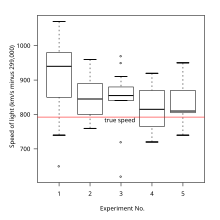Summary statistics

In descriptive statistics, summary statistics are used to summarize a set of observations, in order to communicate the largest amount of information as simply as possible. Statisticians commonly try to describe the observations in
- a measure of location, or central tendency, such as the arithmetic mean
- a measure of statistical dispersion like the standard mean absolute deviation
- a measure of the shape of the distribution like skewness or kurtosis
- if more than one variable is measured, a measure of correlation coefficient
A common collection of
Entries in an analysis of variance table can also be regarded as summary statistics.[1]: 378
Examples
Location
Common measures of location, or central tendency, are the arithmetic mean, median, mode, and interquartile mean.[2][3]
Spread
Common measures of
The Gini coefficient was originally developed to measure income inequality and is equivalent to one of the L-moments.
A simple summary of a dataset is sometimes given by quoting particular
Shape
Common measures of the shape of a distribution are skewness or kurtosis, while alternatives can be based on L-moments. A different measure is the distance skewness, for which a value of zero implies central symmetry.
Dependence
The common measure of dependence between paired random variables is the
Human perception of summary statistics
Humans efficiently use summary statistics to quickly perceive the gist of auditory and visual information.[4][5][6]
See also
- Common test statistics
- Descriptive statistics
- Sample statistics
- Sufficient statistic
- Data processing
References
- OL 23145891M – via Internet Archive. p. 378:
summary statistics [...] *ANOVA table might be referred to as summary statistics
- OL 8370727M.
- ISBN 978-0521519267.
- PMID 23761928.
- PMID 26180505.
- PMID 26317396.
External links
 Media related to Summary statistics at Wikimedia Commons
Media related to Summary statistics at Wikimedia Commons
